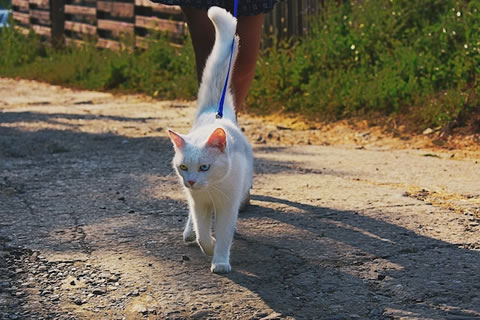Walking my cat on a leash: what should I know when starting

While it may seem unconventional, walking your cat can be a great way for the two of you to bond while providing exercise and mental stimulation for your cat. But before you start taking your cat for walks, there are some things you need to think about.
Not all cats will enjoy walking on a leash
Don't force your cat to walk on a leash because YOU think it's a good idea. Leave the ultimate decision to your cat.
That's not to say your cat will know immediately. Go through the process of teaching your cat to walk on leash in a patient way then see how your cat takes to it. The keyword is patience. Don't make your cat's aversion to walking on leash due to something you did or didn't do.
If you find that it's not for you or your cat you can explore other ways to give your indoor cat an outdoor experience.
How do I give my indoor cat an outdoor experience?
Use a cat harness not a cat collar
A cat collar when pulled with a leash can cause neck injury. A cat harness distributes that pull across a cat's chest and back.
A collar is also much easier to escape from. Use a cat harness to minimize the risk of your cat escaping and running off where it can get lost or hurt.
There's still a small chance your cat can slip out of a harness. So, you want to make sure the harness is well designed, fits your cat, and is put on properly.
How do I get my cat used to wearing a cat harness?
Cats are not dogs
Generally, you can just hook up the leash to a dog's collar and off you go on your walk. Teaching a cat to walk on leash requires patience and a process.
If you think you can just put on the harness, attach the leash, and pull a cat for a walk like a dog, you may find yourself thinking again.
Cats have an instinctual response to just flop onto their side when something is wrapped around their upper body. It's said that it has to do with the natural instinct of going limp when a cat is in a predator's mouth. You'll have to be patient with your cat if you need to overcome that instinct.
How do I choose the right harness for my cat?
Walk your cat where it's safe and quiet
Being outdoors for an inside cat may be a new and overwhelming experience. So, take it slow at first.
Remember, you want to avoid any negative experiences that could set your cat back on learning how to walk on leash. A safe and quiet place will give your cat some time to adjust to a new world.
The two things you don't want is for your cat to be startled and become fearful or your cat to try to get out of the harness and bolt off somewhere. Although some harnesses are more secure than others, no harness is completely escape proof.
Where should I take my cat for a walk?
Carry treats for your cat
Whether you want to reward your cat for good behavior or simply show some affection, having some tasty treats on hand can make your cat's walking experience more enjoyable and reinforce a positive association with it.
You can also use treats to coax your cat to do something or distract from a particular behavior or mental state. However, this may require something more enticing that your cat doesn't normally get to have.
Remember not to overdo it though. A treat stops being special when it's given all the time. It can not only lose it's power to entice but also create an expectation and demand.
Plan on sometimes carrying your cat
Your cat may in no uncertain terms let you know that the walk is over by lying down and refusing to continue. Sometimes you may want to wait your cat out but other times you may just want to pick your cat up and keep moving.
There may be times when you need to reassure your cat when anxious or take your cat elsewhere when there's potential danger. It may also be that you don't want to walk your cat until you arrive at a particular destination.
There are alternatives to carrying your cat in your arms that not only free up your hands but are also more secure and comfortable for both you and your cat. Consider combining one or more of those alternatives with walking on leash.
Alternatives to walking your cat on leash: carriers and strollers
Related Links
-
How do I give my indoor cat an outdoor experience?
-
How do I get my cat used to wearing a cat harness?
-
How do I choose the right harness for my cat?
-
Where should I take my cat for a walk?
-
Alternatives to walking your cat on leash: carriers and strollers
-
2 safe ways to take your cat on a bike ride: baskets and trailers